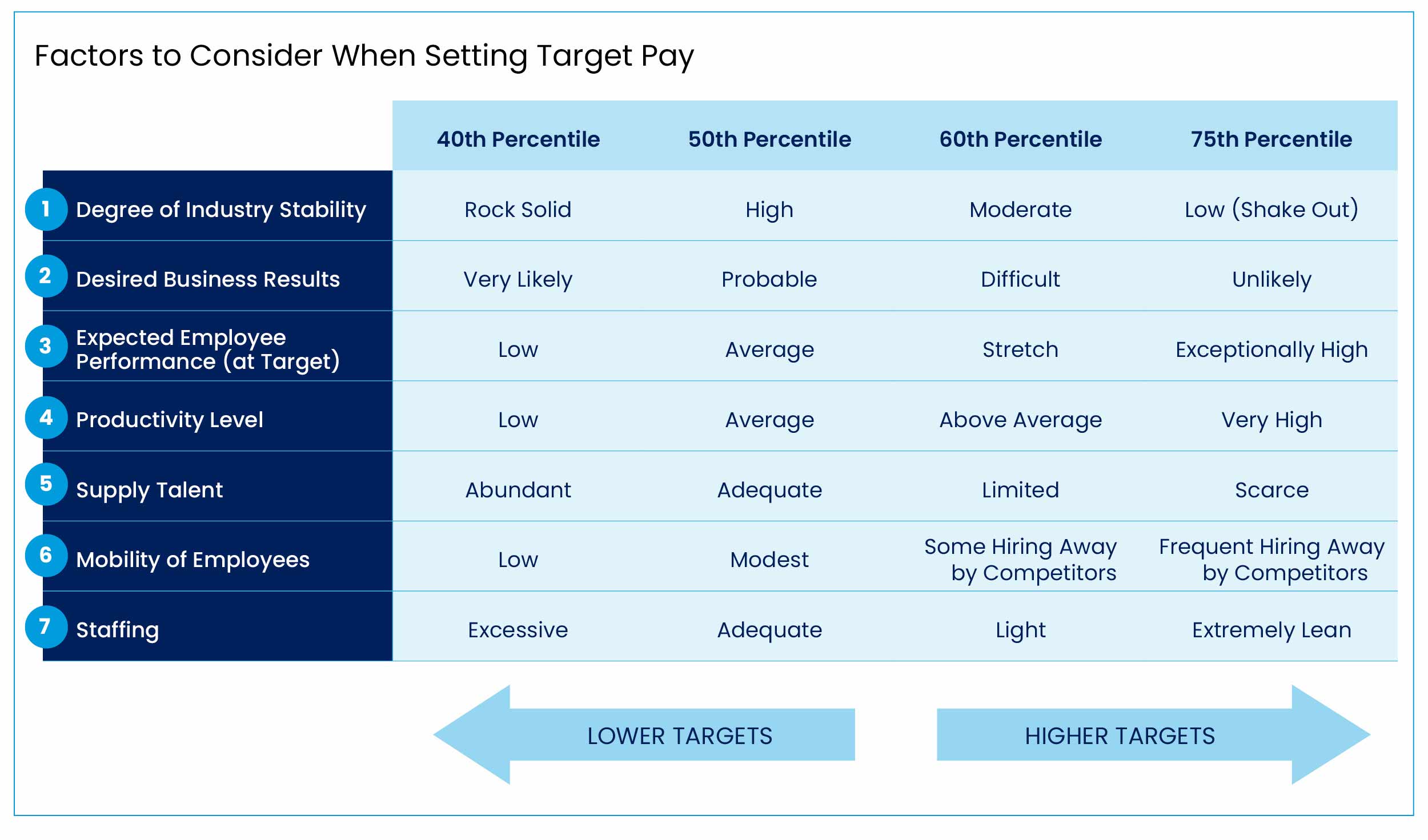- Two types of pay. Base salary (the fixed portion of pay) and incentive pay (the variable portion) are two considerations. Incentive pay may be called a bonus or commission in some plans.
- Positions may vary. While many aggressive pay-for-performance-minded companies wish to pay at the 75th or even the 90th percentile, others prefer a lower profile and set pay below competitive levels.
- Determining pay positioning. Several factors come into play including company stability, employee performance and staffing.
A company’s pay positioning policy is one of the most critical steps in sales compensation design. How a company decides to align itself to the competitive market will have a direct impact on how pay is delivered and what a sales rep can earn for achieving quota.
In the simplest terms, most sales positions earn two types of pay: base salary (the fixed portion of pay) and incentive pay (the variable portion). Incentive pay may be called a bonus or commission in some plans. Together, these two components constitute a sales position’s total target cash compensation (TTC) or on-target-earnings (OTE). This is the total cash compensation a rep receives at their target performance level.
Depending upon a company’s culture or management perspective, how it will position pay targets can vary. Many companies set their pay targets at the median or 50th percentile — right in the middle of the market. While many aggressive pay-for-performance-minded companies wish to pay at the 75th or even the 90th percentile, others prefer a lower profile and set pay below competitive levels.
Often, companies will say they pay at the 75th percentile, but look at their quotas. Do they represent 75th percentile results? If quotas are set at the 75th percentile, reps must perform at that level to earn at that rate.
The reverse holds true as well. Companies with a stable, tenured workforce will more than likely set pay targets at a lower level, maybe the 40th percentile. They can afford this lower positioning against the market because their sales rep turnover has historically been low. The reps are comfortable with the internal equity of pay and market comparison has not been an issue.
The company’s strategy is to build a culture of winners and generate the feeling that “everyone here is a top performer who always makes quota.” The company most likely sets quotas lower at that same 40th percentile — and many reps meet or exceed them. Given performance levels, the company actually pays above and closer to the market rate or the 50th percentile.
How a company decides to align itself to the competitive market will have a direct impact on how pay is delivered and what a sales rep can earn for achieving quota.
Determining Pay Positioning
Seven factors come into play when determining pay positioning. Focusing on these factors helps take the emotion out of the conversation and forces the design team to answer specific questions, and then determine the pay positioning that aligns with the answers.
- Degree of company stability. How solid is the company? Typically, start-up companies must pay more to attract top talent due to the implicit risk in a new venture. The more risk, the more reward is expected. More stable companies, or those with longevity and a proven business case or track record, may have less risk. Stability offers value, which is reflected in the total rewards strategy, allowing the company to consider lower targets.
- Desired business results. How likely is the organization to meet its business goals? Goals that are easily attainable make a case for setting target pay at median or below. Companies with tougher performance goals are more likely to pay much more for those results when achieved.
- Expected employee performance. What is the sales rep’s performance level? As with the previous factor, the tougher the goal, the higher the opportunity will generally be.
- Productivity level. How productive is the organization? This primarily means margins or profit. If the company is profitable and sells or services products that generate a lot of profitability, then more than likely it will/can pay for that through higher targets.
- Supply of talent. How abundant is the talent required for the job? Is it hard to get talented people? If yes, higher targets may be necessary to attract and retain them.
- Mobility of employees. How stable is the sales force? Are the sales reps a group of “hired guns” who frequently move from company to company chasing higher pay? Or, are they stable, loyal and likely to stick it out for the long term? The answer will significantly affect your positioning philosophy.
- Staffing. What’s a rep’s typical workload? Do reps work in teams? Many people performing the same job can lessen the workload on one individual or group of individuals. Similarly, working in teams spreads accountability, possibly giving each individual less influence over a sale. In such cases, target pay may be set lower. Conversely, in a very lean organization, the workload may be greater, thus requiring higher targets for greater effort and responsibility.
The figure below provides a scale of possible responses to the question each factor poses. Responses on the left of the scale suggest that lower to median pay positioning may be appropriate; responses on the right may make a case for higher positioning. As you look to set market rates, these factors should be considered in their entirety, with greater weight given to those factors that the company considers most important.

Editor’s Note: Additional Content
For more information and resources related to this article, see the pages below, which offer quick access to all WorldatWork content on these topics:







